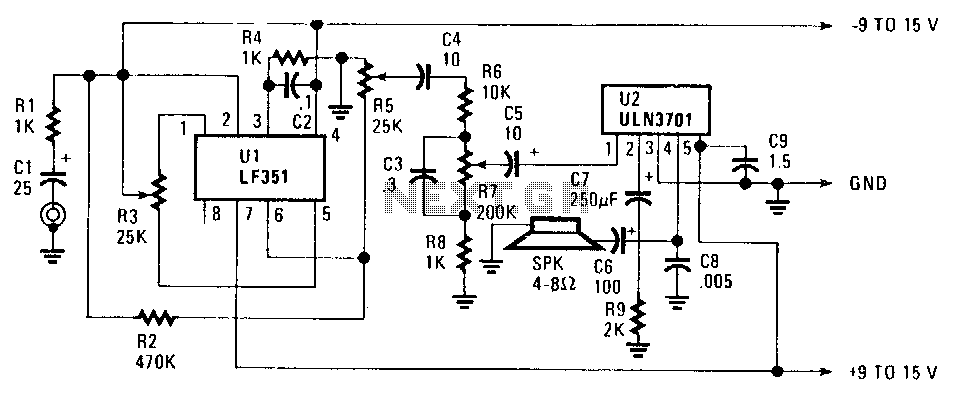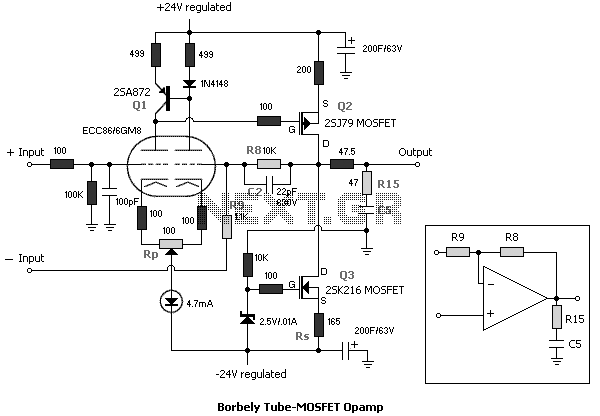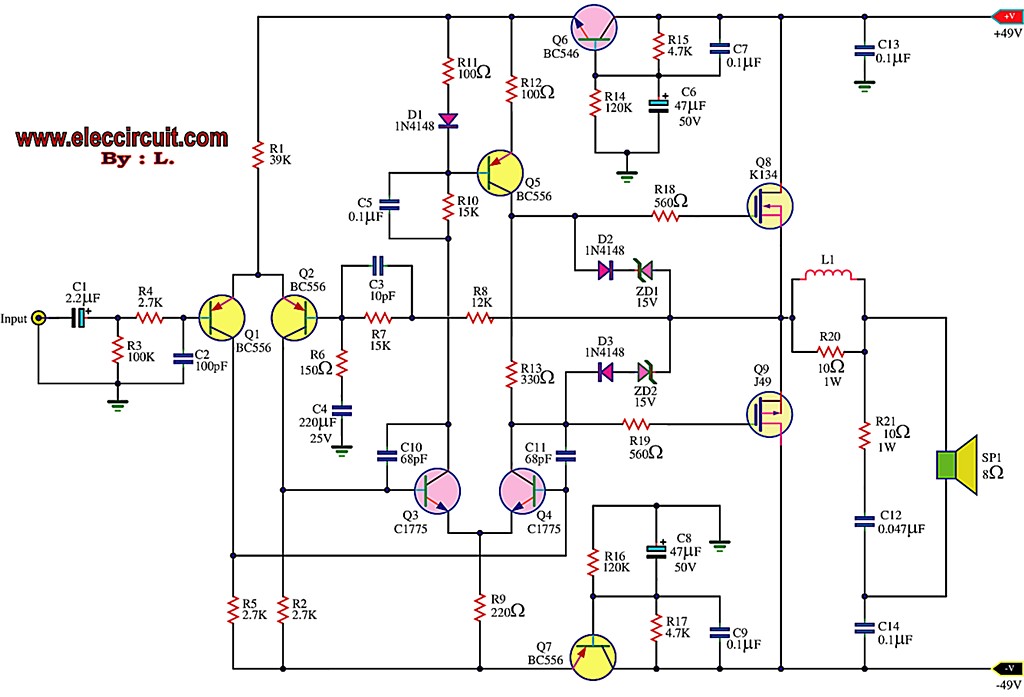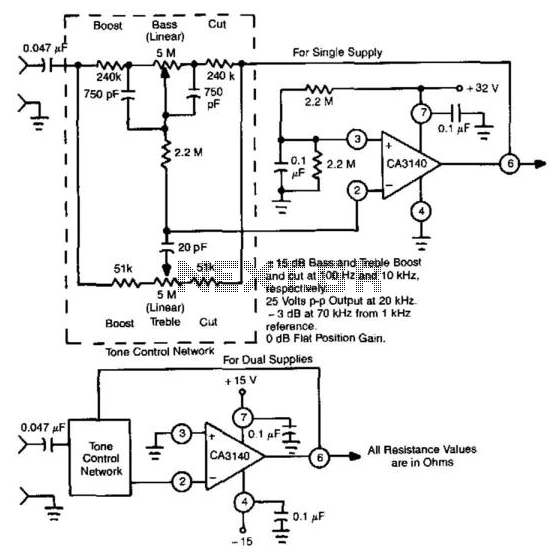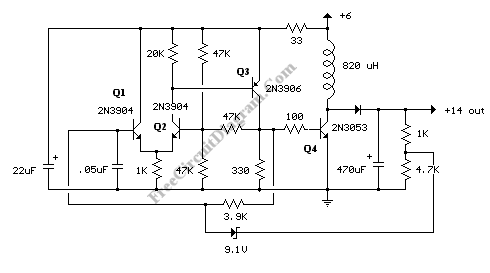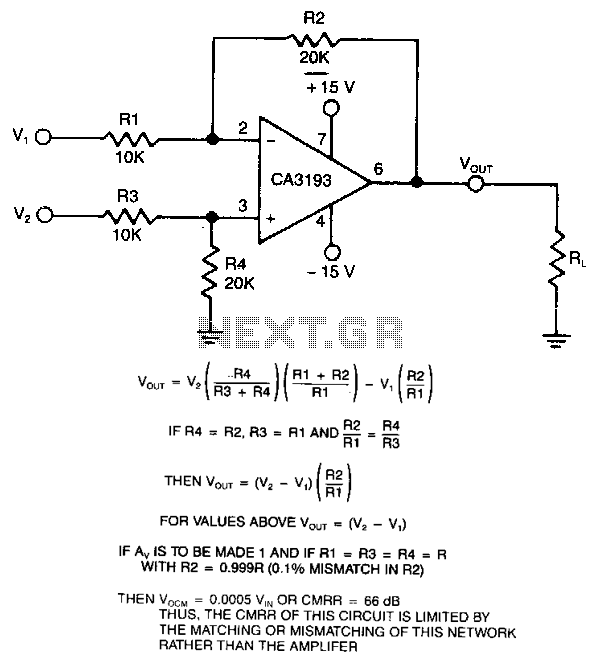
transistor amplifier self bias
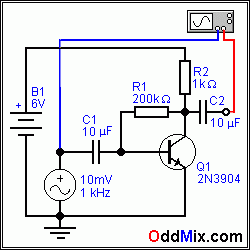
The simplest way to bias a transistor amplifier is through a fixed-bias circuit. The supply voltage is connected to the base terminal of the transistor via the R1 current-limiting resistor. The bias resistor value is typically chosen based on the transistor's gain from its datasheet and the desired operating collector current. Resistor R2 serves as the load resistor for transistor Q1, limiting the collector current to safe levels. The coupling capacitors C1 and C2 are used to separate the AC signals from the DC bias current of the transistor. These capacitors connect the input and output AC signals. In this simple small-signal common emitter transistor amplifier circuit, the input signal is a 1 kHz, 10 mV AC voltage, which is typical for microphones or turntable cartridges that produce similar low-level signals. This amplifier can effectively amplify such signals, and connecting it to the output of a crystal detector radio can noticeably enhance the audio volume output. The amplifier produces a 0.8-volt signal, as indicated by the red trace on the oscilloscope display. Although the output signal is not entirely symmetrical, the minor asymmetry does not impair circuit operation. The blue trace scale is 10 mV per division, while the red trace scale is 1 V per division. The gain of the amplifier, defined as the ratio of output to input signal, is calculated as 800 mV/10 mV = 80. The forward transfer ratio hFE (DC Beta) varies for each 2N3904 transistor, resulting in amplifier gains that may range from below 50 to over 300. Despite this commendable gain, the primary drawback of the self-biased amplifier circuit is its reduced gain and input impedance. The connection of the bias resistor R1 to the load resistor R2 introduces negative feedback, which diminishes amplification. This negative feedback mechanism protects the transistor from thermal runaway by reducing conduction as the collector current increases, thereby decreasing the bias current. The parts list for this one-transistor audio amplifier includes: C1 and C2 - Electrolytic Capacitors (10 µF, 6-10 VDC), R1 - Resistor (200 K, 1/4 Watt Carbon), R2 - Resistor (1 K, 1/4 Watt Carbon), Q1 - Transistor (2N3904, NPN, silicon, amplifier), B1 - Battery (6 Volt, 4 AA cells).
The fixed-bias circuit for this transistor amplifier is a straightforward yet effective design, suitable for small-signal amplification applications. The choice of components is crucial for achieving optimal performance. The R1 resistor, typically set at 200 KΩ, is selected to establish a suitable base current that allows for the desired collector current based on the transistor's hFE. The load resistor R2, at 1 KΩ, ensures that the collector current remains within safe limits, preventing damage to the transistor during operation.
The coupling capacitors C1 and C2 play a vital role in the circuit by blocking any DC component from the input and output signals, allowing only the AC signals to pass through. This feature is essential for maintaining the integrity of the audio signal being amplified. The use of electrolytic capacitors rated for at least 10 µF and 6-10 VDC ensures that the capacitors can handle the voltage levels present in the circuit without failure.
In terms of performance, the amplifier is capable of handling low-level audio signals, making it ideal for use with microphones and other audio sources that produce similar signal levels. The gain of the amplifier, calculated at 80, indicates a significant increase in signal strength, facilitating better audio output when connected to devices such as crystal detector radios.
The design also incorporates protective features through negative feedback, which stabilizes the amplifier's performance under varying load conditions. As the collector current increases, the feedback mechanism reduces the base current, effectively preventing thermal runaway, which can lead to transistor failure.
Overall, this simple fixed-bias transistor amplifier circuit demonstrates the fundamental principles of transistor operation and biasing while providing a reliable solution for low-level audio amplification. The careful selection of components and design considerations ensures that the amplifier operates efficiently and safely within its specified parameters.The simplest way to bias a transistor amplifier is by the fixed-bias circuit. The supply voltage is connected to the transistor`s base terminal trough the R1 current limiting resistor. The value of the bias resistor is usually selected based on the transistor`s gain from its data sheet and the selected operating collector current.
Resistor R2 is t he load resistor for transistor Q1. The function of this R2 load resistor is to limit the collector current to safe values. The C1 and C2 coupling capacitors are used to separate the AC signals from the transistor`s DC bias current. Through these two capacitors, C1 and C2 connect the input and output AC [Alternating Current] signals.
In our simple, small signal, common emitter, transistor amplifier circuit the input signal is a 1 kHz 10 mV AC voltage. Usually microphones or turntable cartridges have similarly small signal levels. Thus our simple amplifier can be used to amplify similar low-level signals. Attaching the same amplifier to the output of a crystal detector radio would result in noticeable improvement in the output audio volume.
This amplifier outputs a 0. 8-Volt signal as shown by the red trace on the oscilloscope display - Figure 2. Notice that the output signal is not completely symmetrical, but the minor asymmetry does not affect the circuit operation. The scale for the blue trace is 10 mV per division and for the red trace it is 1 V per division. Since the gain of an amplifier is the ratio of the output to the input signal this amplifier stage has an AC gain of 800 mV/10 mV = 80.
Since the forward transfer ratio hFE (DC Beta) or gain is different for each 2N3904 transistor, the amplifier gain may vary from below 50 to 300 or more. In spite of this respectable gain the self biased amplifier circuits largest drawback is reduced gain and input impedance.
Because the bias resistor R1 of this amplifier is connected to the R2 load resistor there is a negative feedback that works to reduce the amplification. Because of this negative feedback this type of amplifier circuit protects the transistor against self distract by thermal runaway.
As the collector current increases, the bias current decreases and that forces a reduction in the transistor`s conduction. Parts list for this one transistor audio amplifier: C1, C2 - Electrolytic Capacitor 10 uF 6-10 VDC R1 - Resistor, 200 K, 1/4 Watt Carbon R2 - Resistor, 1 K, 1/4 Watt Carbon Q1 - Transistor 2N3904, NPN, silicon, amplifier B1 - Battery - 6 Volt, 4 AA cells
🔗 External reference
The fixed-bias circuit for this transistor amplifier is a straightforward yet effective design, suitable for small-signal amplification applications. The choice of components is crucial for achieving optimal performance. The R1 resistor, typically set at 200 KΩ, is selected to establish a suitable base current that allows for the desired collector current based on the transistor's hFE. The load resistor R2, at 1 KΩ, ensures that the collector current remains within safe limits, preventing damage to the transistor during operation.
The coupling capacitors C1 and C2 play a vital role in the circuit by blocking any DC component from the input and output signals, allowing only the AC signals to pass through. This feature is essential for maintaining the integrity of the audio signal being amplified. The use of electrolytic capacitors rated for at least 10 µF and 6-10 VDC ensures that the capacitors can handle the voltage levels present in the circuit without failure.
In terms of performance, the amplifier is capable of handling low-level audio signals, making it ideal for use with microphones and other audio sources that produce similar signal levels. The gain of the amplifier, calculated at 80, indicates a significant increase in signal strength, facilitating better audio output when connected to devices such as crystal detector radios.
The design also incorporates protective features through negative feedback, which stabilizes the amplifier's performance under varying load conditions. As the collector current increases, the feedback mechanism reduces the base current, effectively preventing thermal runaway, which can lead to transistor failure.
Overall, this simple fixed-bias transistor amplifier circuit demonstrates the fundamental principles of transistor operation and biasing while providing a reliable solution for low-level audio amplification. The careful selection of components and design considerations ensures that the amplifier operates efficiently and safely within its specified parameters.The simplest way to bias a transistor amplifier is by the fixed-bias circuit. The supply voltage is connected to the transistor`s base terminal trough the R1 current limiting resistor. The value of the bias resistor is usually selected based on the transistor`s gain from its data sheet and the selected operating collector current.
Resistor R2 is t he load resistor for transistor Q1. The function of this R2 load resistor is to limit the collector current to safe values. The C1 and C2 coupling capacitors are used to separate the AC signals from the transistor`s DC bias current. Through these two capacitors, C1 and C2 connect the input and output AC [Alternating Current] signals.
In our simple, small signal, common emitter, transistor amplifier circuit the input signal is a 1 kHz 10 mV AC voltage. Usually microphones or turntable cartridges have similarly small signal levels. Thus our simple amplifier can be used to amplify similar low-level signals. Attaching the same amplifier to the output of a crystal detector radio would result in noticeable improvement in the output audio volume.
This amplifier outputs a 0. 8-Volt signal as shown by the red trace on the oscilloscope display - Figure 2. Notice that the output signal is not completely symmetrical, but the minor asymmetry does not affect the circuit operation. The scale for the blue trace is 10 mV per division and for the red trace it is 1 V per division. Since the gain of an amplifier is the ratio of the output to the input signal this amplifier stage has an AC gain of 800 mV/10 mV = 80.
Since the forward transfer ratio hFE (DC Beta) or gain is different for each 2N3904 transistor, the amplifier gain may vary from below 50 to 300 or more. In spite of this respectable gain the self biased amplifier circuits largest drawback is reduced gain and input impedance.
Because the bias resistor R1 of this amplifier is connected to the R2 load resistor there is a negative feedback that works to reduce the amplification. Because of this negative feedback this type of amplifier circuit protects the transistor against self distract by thermal runaway.
As the collector current increases, the bias current decreases and that forces a reduction in the transistor`s conduction. Parts list for this one transistor audio amplifier: C1, C2 - Electrolytic Capacitor 10 uF 6-10 VDC R1 - Resistor, 200 K, 1/4 Watt Carbon R2 - Resistor, 1 K, 1/4 Watt Carbon Q1 - Transistor 2N3904, NPN, silicon, amplifier B1 - Battery - 6 Volt, 4 AA cells
🔗 External reference
